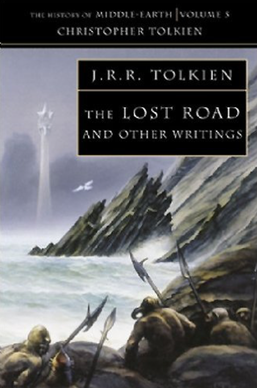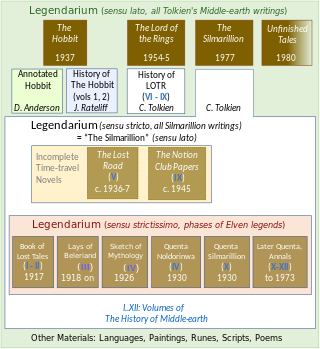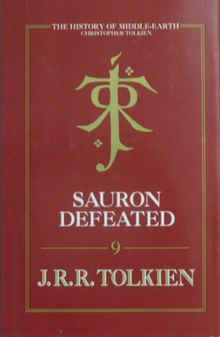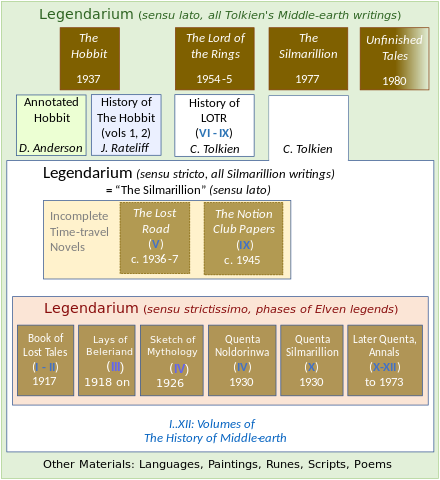Gil-galad is a fictional character in J. R. R. Tolkien's Middle-earth legendarium, the last high king of the Noldor, one of the main divisions of Elves. He is mentioned in The Lord of the Rings, where the hobbit Sam Gamgee recites a fragment of a poem about him, and The Silmarillion. In the Last Alliance of Elves and Men, Gil-galad and Elendil laid siege to the Dark Lord Sauron's fortress of Barad-dûr, and fought him hand-to-hand for the One Ring. Both Gil-galad and Elendil were killed, and Elendil's son Isildur took the Ring for himself. Gil-galad briefly appears at the opening of Peter Jackson's The Lord of the Rings film trilogy, and features in several video games based on Tolkien's Middle-earth.

Unfinished Tales of Númenor and Middle-earth is a collection of stories and essays by J. R. R. Tolkien that were never completed during his lifetime, but were edited by his son Christopher Tolkien and published in 1980. Many of the tales within are retold in The Silmarillion, albeit in modified forms; the work also contains a summary of the events of The Lord of the Rings told from a less personal perspective.

Morgoth's Ring (1993) is the tenth volume of Christopher Tolkien's 12-volume series The History of Middle-earth in which he analyses the unpublished manuscripts of his father J. R. R. Tolkien.

The War of the Jewels (1994) is the 11th volume of Christopher Tolkien's series The History of Middle-earth, analysing the unpublished manuscripts of his father J. R. R. Tolkien. It is the second of two volumes—Morgoth's Ring being the first—to explore the later 1951 Silmarillion drafts.

The Peoples of Middle-earth (1996) is the 12th and final volume of The History of Middle-earth, edited by Christopher Tolkien from the unpublished manuscripts of his father J. R. R. Tolkien. Some characters only appear here, as do a few other works that did not fit anywhere else.

The Lost Road and Other Writings – Language and Legend before 'The Lord of the Rings' is the fifth volume of The History of Middle-earth, a series of compilations of drafts and essays written by J. R. R. Tolkien in around 1936–1937. It was edited and published posthumously in 1987 by Christopher Tolkien.

The Book of Lost Tales is a collection of early stories by the English writer J. R. R. Tolkien, published as the first two volumes of Christopher Tolkien's 12-volume series The History of Middle-earth, in which he presents and analyses the manuscripts of those stories, which were the earliest form of the complex fictional myths that would eventually comprise The Silmarillion. Each of the Tales is followed by notes and a detailed commentary by Christopher Tolkien.
Tolkien fandom is an international, informal community of fans of the works of J. R. R. Tolkien, especially of the Middle-earth legendarium which includes The Hobbit, The Lord of the Rings, and The Silmarillion. The concept of Tolkien fandom as a specific type of fan subculture sprang up in the United States in the 1960s, in the context of the hippie movement, to the dismay of the author, who talked of "my deplorable cultus".

The Complete Guide to Middle-earth: from The Hobbit to The Silmarillion is a reference book for J. R. R. Tolkien's fictional universe of Middle-earth, compiled and edited by Robert Foster. It was first published in 1971 under the title A Guide to Middle-earth. A revised and enlarged edition under the title The Complete Guide to Middle-earth was published in 1978. It received a third edition in 2001.
The following outline is provided as an overview of and topical guide to the real-world history and notable fictional elements of J. R. R. Tolkien's fantasy universe. It covers materials created by Tolkien; the works on his unpublished manuscripts, by his son Christopher Tolkien; and films, games and other media created by other people.
The term Middle-earth canon, also called Tolkien's canon, is used for the published writings of J. R. R. Tolkien regarding Middle-earth as a whole. The term is also used in Tolkien fandom to promote, discuss and debate the idea of a consistent fictional canon within a given subset of Tolkien's writings.

Beren and Lúthien is a compilation of multiple versions of the epic fantasy Lúthien and Beren by J. R. R. Tolkien, one of Tolkien's earliest tales of Middle-earth. It is edited by Christopher Tolkien. It is the story of the love and adventures of the mortal Man Beren and the immortal Elf-maiden Lúthien. Tolkien wrote several versions of their story, the last in The Silmarillion, and the tale is also mentioned in The Lord of the Rings at the council of Elrond. The story takes place during the First Age of Middle-earth, about 6,500 years before the events of The Hobbit and The Lord of the Rings.

Tolkien's legendarium is the body of J. R. R. Tolkien's mythopoeic writing, unpublished in his lifetime, that forms the background to his The Lord of the Rings, and which his son Christopher summarized in his compilation of The Silmarillion and documented in his 12-volume series The History of Middle-earth. The legendarium's origins reach back to 1914, when Tolkien began writing poems and story sketches, drawing maps, and inventing languages and names as a private project to create a mythology for England. The earliest story drafts are from 1916; he revised and rewrote these for most of his adult life.

Tolkien's Legendarium: Essays on The History of Middle-earth is a collection of scholarly essays edited by Verlyn Flieger and Carl F. Hostetter on the 12 volumes of The History of Middle-earth, relating to J. R. R. Tolkien's fiction and compiled and edited by his son, Christopher. It was published by Greenwood Press in 2000. That series comprises a substantial part of "Tolkien's legendarium", the body of Tolkien's mythopoeic writing that forms the background to his The Lord of the Rings and which Christopher Tolkien summarized in his compilation of The Silmarillion.

The History of The Hobbit is a two-volume study of J. R. R. Tolkien's 1937 children's fantasy novel The Hobbit. It was first published by HarperCollins in 2007. It contains Tolkien's unpublished drafts of the novel, with commentary by John D. Rateliff. It details Tolkien's various revisions to The Hobbit, including abandoned revisions for the unpublished third edition of the work, intended for 1960, as well as previously unpublished original maps and illustrations drawn by Tolkien.

The Road to Middle-Earth: How J. R. R. Tolkien Created a New Mythology is a scholarly study of the Middle-earth works of J. R. R. Tolkien written by Tom Shippey and first published in 1982. The book discusses Tolkien's philology, and then examines in turn the origins of The Hobbit, The Lord of the Rings, The Silmarillion, and his minor works. An appendix discusses Tolkien's many sources. Two further editions extended and updated the work, including a discussion of Peter Jackson's film version of The Lord of the Rings.

The Fellowship of the Ring is the first of three volumes of the epic novel The Lord of the Rings by the English author J. R. R. Tolkien. It is followed by The Two Towers and The Return of the King. The action takes place in the fictional universe of Middle-earth. The book was first published on 29 July 1954 in the United Kingdom. The volume consists of a foreword, in which the author discusses his writing of The Lord of the Rings, a prologue titled "Concerning Hobbits, and other matters", and the main narrative in Book I and Book II.

The Silmarillion is a book consisting of a collection of myths and stories in varying styles by the English writer J. R. R. Tolkien. It was edited and published posthumously by his son Christopher Tolkien in 1977, assisted by Guy Gavriel Kay, who became a fantasy author. It tells of Eä, a fictional universe that includes the Blessed Realm of Valinor, the ill-fated region of Beleriand, the island of Númenor, and the continent of Middle-earth, where Tolkien's most popular works—The Hobbit and The Lord of the Rings—are set. After the success of The Hobbit, Tolkien's publisher, Stanley Unwin, requested a sequel, and Tolkien offered a draft of the writings that would later become The Silmarillion. Unwin rejected this proposal, calling the draft obscure and "too Celtic", so Tolkien began working on a new story that eventually became The Lord of the Rings.
J. R. R. Tolkien used frame stories throughout his Middle-earth writings, especially his legendarium, to make the works resemble a genuine mythology written and edited by many hands over a long period of time. He described in detail how his fictional characters wrote their books and transmitted them to others, and showed how later in-universe editors annotated the material.
J. R. R. Tolkien called his 1954–55 book The Lord of the Rings a heroic romance, giving it a medieval feeling, and describing its time-frame as the remote past. He took care to make its setting, Middle-earth, believable by developing its geography, history, peoples, genealogies, and unseen background in great detail. He created a powerful impression of depth by hinting in many places at the unseen background. Further, he decided to increase the reader's feeling that the story was real by creating an elaborate, many-faceted editorial framing of The Lord of the Rings, surrounding the main text with metatextual appendices that extend and comment upon it. This effectively includes an editorial figure much like himself who is interested in philology, and who edits and translates the manuscript which has somehow come into his hands, having somehow survived the thousands of years since the Third Age.















